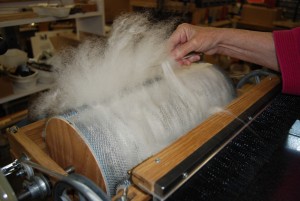 A drum carder is used to arrange fibers in a basic parallel direction, distribute them more evenly and make them easier to spin. The carder can process a far greater amount of fiber in a shorter time than hand cards. But it does take some practice. Here are some basic issues you may encounter:
A drum carder is used to arrange fibers in a basic parallel direction, distribute them more evenly and make them easier to spin. The carder can process a far greater amount of fiber in a shorter time than hand cards. But it does take some practice. Here are some basic issues you may encounter:
1. There are lumps in the batt
a. You’re feeding in too much fiber, too fast
b. The fiber needs to be teased more before you feed it in
c. You need to distribute the fiber more evenly across the infeed tray
d. The drums may need to be adjusted
2. The fiber won’t feed through to the swift (big drum)
a. You’re feeding in too much fiber, too fast
b. The fiber needs to be teased more before you feed it in
3. Fiber is accumulating on the licker-in drum
a. You’re holding back on the fiber on the infeed tray
b. The swift (big drum) is full and cannot hold any more fiber
c. The fiber is too short
d. The space between the drums may need to be adjusted
4. The hand crank is hard to turn
a. You’re feeding in too much fiber, too fast
b. The fiber needs to be teased more before you feed it in
c. Fibers are wedged around the axle of the drum
d. The crank needs oiling
